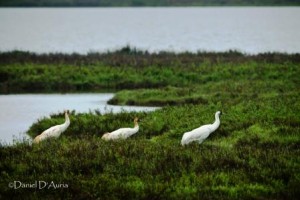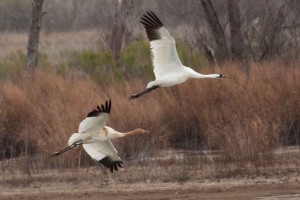Archive for the ‘Aransas NWR Updates’ Category
Aransas National Wildlife Refuge Update
April 26, 2012The Aransas National Wildlife Refuge, U.S. Fish and Wildlife Service issued its update report on April 26, 2012. All of the whooping cranes that wintered on the refuge have now departed for their Canadian nesting grounds. Some cranes have already reached the nesting area.
Whooping Crane Update –April 12, 2012
April 12, 2012Aransas National Wildlife Refuge has completed its update report on the status of whooping cranes on the refuge, migration progress, current habitat conditions, and status on birds found dead. To read the full report click on the following link:
Aransas National Wildlife Refuge Update Report (041212_WCUpdate)
Aransas National Wildlife Refuge Update
March 29, 2012Aransas National Wildlife Refuge, U.S. Fish and Wildlife Service issued a report today describing the status of the whooping crane population on the refuge, water conditions and habitat improvements. Some whooping cranes have already started their migration north towards their nesting area at Buffalo National Park, Canada. Click on the following ling for the full report:
Whooping Crane Update – Aransas Refuge
March 29, 2012Whooping Crane Update –Aransas Refuge, U.S. Fish and Wildlife Service, March 29, 2012
Precipitation/Salinity:
As of March 28, the monthly precipitation totals for Aransas National Wildlife Refuge are 2.41 inches and salinity levels in San Antonio Bay are recorded as 19.7 parts per thousand. With salinity levels below 20 parts per thousand, conditions in the marsh continue to normalize and food production for the birds improves. Even so, the refuge is still not to pre-drought conditions and biologists remain concerned. Photo by Daniel D’Auria
Food Sources:
Since the last update, the refuge has completed all of the prescribed burns for the season. The changing weather makes it difficult to safely and effectively conduct any more. The refuge was able to burn a total of 12,310 acres of habitat, areas targeted because of their value to whooping crane food source.
Reports:
The refuge is still waiting on the final report from the second carcass (recovered January 18). The third carcass (recovered February 29, 2012) was examined by the National Wildlife Health Center in Madison, WI. Results from this necropsy were inconclusive due to the extensive scavenging that had occurred to the carcass. However, bone marrow was found to contain
several bacteria strains.
The refuge will issue a final ‘State of the Cranes’ report summarizing the significant events that occurred during the 2011-12 whooping crane season.
Surveys:
Biologists hope to get in one last flight before the change in weather makes it too difficult. A flight is scheduled for today, Thursday March 29th. Analysis of data collected from previous surveys is still ongoing and will be presented in the annual report provided by the refuge.
Radio-marked birds and sightings of cranes from the flyway indicate the birds have begun their northern migration back to Wood Buffalo National Park in the Northwest Territories of Canada where they nest exclusively.
Supplemental Feeding:
The refuge continues to get questions regarding supplemental feeding. At this time, the refuge is concerned about the negative impacts of supplemental feeding. Previous efforts to supplemental feed were not considered successful as only a small portion of the birds actually fed on the shelled corn. Whooping cranes are territorial and do not naturally gather together to feed. Encouraging them to do so changes their natural behavior; it also creates greater opportunities to transmit diseases, parasites, and makes them more vulnerable to predators. Furthermore, when left out in warm and moist environments, like coastal marsh
areas, corn can grow Aspergillis molds. Aflatoxins, which are produced by the molds, can be lethal to whooping cranes and other wildlife. Where whooping cranes may be present, landowners should be aware of the risks that aflatoxins pose. If corn is being used for feeding other wildlife in areas where whooping cranes may be present, we highly recommend purchasing aflatoxin-free corn.
Aransas NWR Update 3-1-2012
March 1, 2012Aransas National Wildlife Refuge, U.S. Fish and Wildlife Service posted its Update Report on 3-1-2012. A new aerial census was completed in February but an analysis of the numbers has not been completed. New whooping crane census numbers will be reported as soon as analysis is complete. Recent rain fall has helped lower the salinity levels in area bays where the whooping cranes feed. More prescribed fires have been completed making more food available to the cranes.
Click on link to read full report: 030112_WCUpdate 3-1-12
Whooping Crane Update, February 16, 2012
February 17, 2012Aransas National Wildlife Refuge reports that a new census technique is being used to estimate whooping crane numbers on the refuge. The estimated number of birds, based on three aerial flights within the survey area is 245. This does not include birds known to be in 5 Texas counties and other states. Recent rain fall has helped lower the salinity levels in area bays where the whooping cranes feed. Click on link to read full report: wc update 2_16_12
Whooping Crane Update – February 2, 2012
February 7, 2012Whooping Crane Update wc updated 2_2_12 #2
Aransas National Wildlife Refuge provides its Whooping Crane Update, February 2, 2012. The report contains current numbers of whooping cranes counted by an aerial survey, habitat conditions on the refuge and rain fall updates.
209 Whooping Cranes Counted on Aransas NWR
February 3, 2012by Whooping Crane Conservation Association based on Aransas NWR report
Aerial surveys of the whooping crane population wintering on the Aransas National Wildlife Refuge were performed by U.S. Fish and Wildlife Service biologists last week. Refuge biologists have just completed their analysis of the census data and made their findings available. Three aerial surveys were conducted. A survey on January 26th was cut short due to high winds. Surveys conducted on January 27th and 29th were approximately 4 1/2 hours and each systematically searched Matagorda Island, San Jose Island, Blackjack Peninsula, Lamar Peninsula, Dewberry Island, and Welder Flats. Conditions for surveying were most favorable on January 29th, when observers detected 193 whooping cranes. Of the 193 cranes, 125 were white plumage birds, 23 were juvenile birds, and 3 were undistinguished.
The numbers do not represent a complete “census” of birds in the surveyed area, but will provide biologists a means to estimate the whooping crane population size. It is possible that some of the whoopers on the refuge were not detected by the observers. Analysis of these data is ongoing.
At least 16 additional Aransas-Wood Buffalo population of whooping cranes are currently residing outside of the typical wintering area, as far away as Nebraska. Based on the available data, 209 whoopers have been accounted for. The next survey flight will be scheduled for mid-February.
Approximately 5% of whooping cranes detected on the 27th and 29th were found using man-made freshwater sources, such as stock ponds and windmills. Cranes were using both upland and marsh communities. They are naturally supplementing their own food sources by wintering around freshwater lakes.
Refuge personnel continue to help alleviate the low food resources by adding to the prescribed burn totals. This winter the refuge has burned 8,095 acres of habitat that have recorded whooping crane usage. Biologists observed the whooping cranes eating roasted acorns and are seeing continued use. There are still an additional 6,129 acres planned to be burn for the remaining whooping crane season.
Many people have inquired whether the refuge plans to implement a supplemental feeding program for whooping cranes this winter. At this time, refuge officials are concerned about the negative impacts of supplemental feeding. Previous efforts to supplemental feed were not considered successful as only a small portion of the birds actually fed on the shelled corn.
Whooping cranes are territorial and do not naturally gather together to feed. Encouraging them to do so changes their natural behavior; it also creates greater opportunities to transmit diseases, parasites, and makes them more vulnerable to predators. Furthermore, when left out in warm and moist environments, like coastal marsh areas, corn can grow Aspergillis molds. Aflatoxins, which are produced by the molds, can be lethal to whooping cranes and other wildlife. Where whooping cranes may be present, landowners should be aware of the risks that aflatoxins pose. If corn is being be used for feeding other wildlife in areas where whooping cranes may be present, U.S. Fish and Wildlife Service scientists highly recommend purchasing aflatoxin-free corn.
Aransas National Wildlife Refuge has received 0.84 inches of precipitation for the month of January. Central Texas has been fortunate to receive some much needed rainfall recently and the water has raised the Guadalupe River to above flood stage levels from Jan 28th- Jan 31st. This river flows into the San Antonio Bay and the flush of freshwater is expected to further decrease salinity levels. Currently, salinity levels are reported to be 23.2 parts per thousand (ppt) compared to 35.3ppt on December 14, 2011.
January 24th data from Texas Parks and Wildlife Department indicates that samples taken in the San Antonio, East Matagorda, and Espiritu bays were free of red tide. It
is still persisting in some of the surrounding bays but in very low concentrations.
Aransas Refuge officials reported that a second radioed whooping crane chick has died this winter since their last report. The carcass has been sent off for testing and we are awaiting results.
Aerial survey flights to estimate the whooping crane population
January 18, 2012Aerial survey flights to estimate the whooping crane population on their wintering grounds has been scheduled the week of January 23rd with the office of Migratory Birds within the U.S. Fish and Wildlife Service. The surveys will consist of 3 consecutive flights to increase the accuracy of the population estimate. An update will be posted once biologists process the flight data
Read the latest from Aransas NWR.
Aransas NWR Update December 14, 2011
December 14, 2011Individuals of the Aransas-Wood Buffalo whooping crane population began arriving on the Texas coastal bend and Aransas National Wildlife Refuge wintering grounds in late October.


